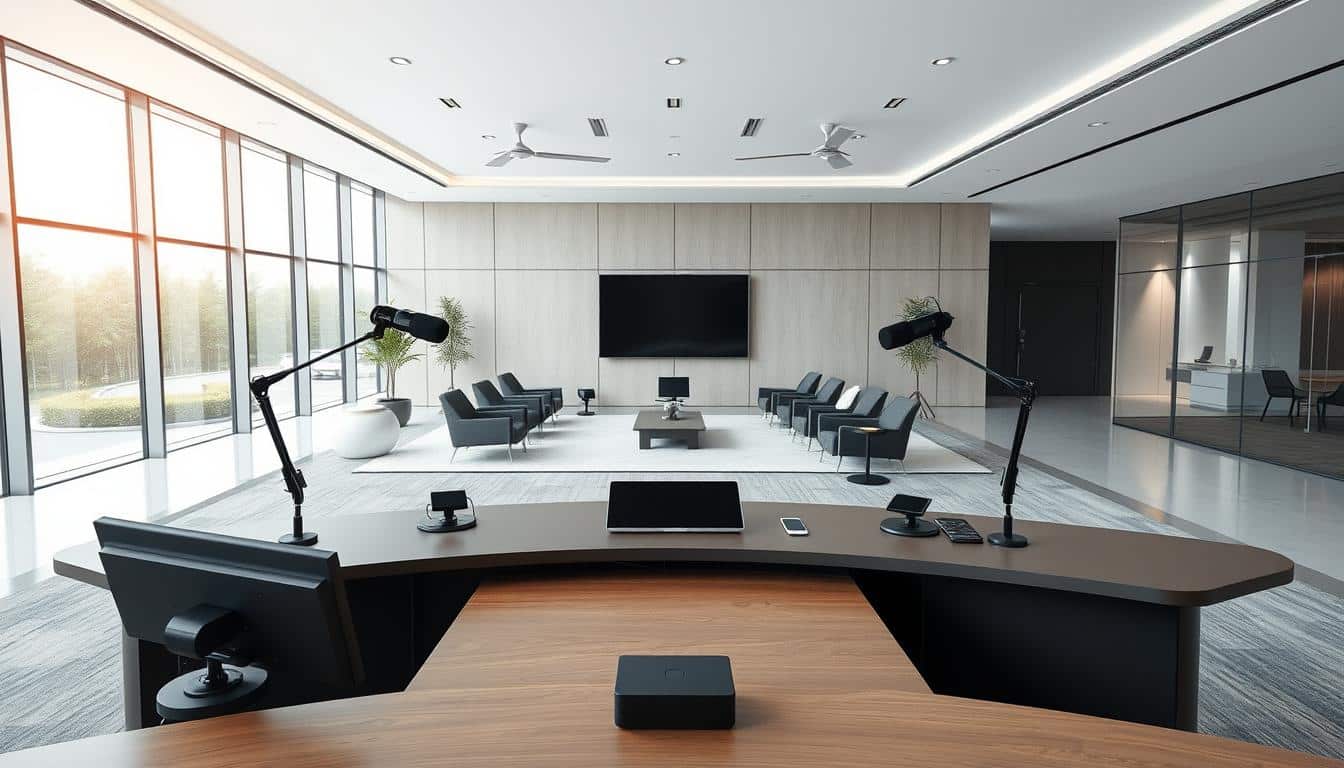In today’s fast world, a good online meeting setup guide is essential. With more folks working remotely, video conferencing is key for meetings. This guide is a complete resource for improving online team work.
With changes in how we work, getting the right video meeting tools is vital. We’ll help you pick the best services, like Microsoft Teams, Zoom, and Google Meet. Plus, we’ll ensure you have the top audio and visual gear for smooth meetings.
Anúncios
Let’s dive into making your online meetings better and more productive. Follow this guide for successful virtual team work.
Understanding the Importance of Online Meetings
Nowadays, online meetings are a big deal for remote work. Teams can meet from anywhere, cutting down on travel. By 2025, half of all company events will be online. Embracing these tools saves money on travel and office space, making video conferencing very useful.
Online meetings feel like you’re there in person. They keep everyone involved. Features like real-time translation and noise cancellation make meetings better. Plus, tools like screen sharing and chat boost productivity. Make sure to plan your meeting right, whether it’s a big presentation or a small group session.
Having a clear agenda helps outline the meeting’s goals and what everyone should do. Picking times that work for all time zones makes more people join in. Send out any important documents two days before so everyone’s ready. Using slides can keep attention on the meeting.
Tools like polls and notes can make meetings more interactive. Always check your tech before starting and have a backup plan. Letting people know expectations, like muting their mic when not talking, makes things run smoother. Visual aids and a test run before the real thing are key. And, having someone ready to fix any tech issues helps everyone feel at ease.
Choosing the Right Video Conferencing Software
Finding the best video conferencing software is key for good online meetings. There are many choices, like Microsoft Teams, Zoom, Google Meet, and Webex. Each offers special features for different needs.
Before choosing, consider these points:
- User interface: An easy-to-use interface makes things easier for everyone.
- Integration capabilities: The software should work well with other tools you use.
- Security features: Choose options that keep your data safe.
- Pricing plans: Know the costs to stay within your budget.
Look for these essential features:
- Scalability: Some, like Zoom, can handle up to 10,000 people in their biggest plan.
- AI-powered transcription and virtual backgrounds make meetings better.
- Breakout rooms and annotation tools help with teamwork.
- Cloud storage and 24/7 phone support fix problems fast.
The top video conferencing tools for 2024 focus on strong security, ease of use, and great teamwork features. Check your internet speed; you need at least 10 Mbps download and 2 Mbps upload for it to work well. A cable connection is more reliable than Wi-Fi, making videos and sound clearer. Using virtual backgrounds and filters makes your presentation look more professional and keeps distractions away.
Essential Hardware for the Best Online Meeting Setup
A good video meeting setup needs the right hardware. The most important part is a computer that works with video meeting apps. Virtual meetings work best with several key pieces for a smooth experience.
Better equipment improves video and sound, making meetings more engaging. Here are key items for a great online meeting:
- Cameras: For small spaces, try the Logitech C920 or Microsoft LifeCam Studio. The Logitech Rally and Huddly Go are good for bigger rooms.
- Multi-purpose spaces: The Logitech MeetUp and Poly Studio X50 are great for flexible use.
- Microphones: The Blue Yeti USB mic cancels noise and produces clear sound, perfect for understandable audio.
- Webcams: The Dell Pro 2K Webcam has great software for Mac users, keeping you in frame. The Opal Tadpole is small but gives better video than most laptop cams.
- Accessories: Using a phone tripod mount lets you multitask. It uses your phone’s better camera and mic while freeing your laptop.
Each item has a special role, making sure everyone can talk clearly, no matter the room size. Choosing the right gear improves any meeting, whether in a small or large space.
Invest in the Right Monitor
Choosing the right monitor for video conferencing is key. It’s the main visual part of your meetings. Look for a monitor that’s big and has clear resolution for a better view during video calls. Also, pick a monitor with a high refresh rate for smooth pictures, which is a must in professional settings.
Choosing the Size and Resolution for Your Needs
Size and resolution are vital when picking a monitor for video calls. Go for bigger screens like:
- BenQ 27-inch monitor with 1080p resolution
- Dell 34-inch ultrawide monitor featuring 1440p resolution and 165Hz refresh rate
- LG DualUp 32-inch ultrawide monitor offering a unique 16:18 aspect ratio
- Plugable 15.6-inch portable monitor with 1080p resolution for on-the-go uses
With these options, everyone can see and interact with the shared content easily.
Benefits of Video Conferencing Monitors
Video conferencing monitors offer many upsides. They include built-in cameras, mics, and speakers so you don’t need extra gear. These benefits are:
- Boosted productivity with clear visuals and less desk clutter
- Better sound quality from top-brand certified speakers
- Good ergonomics for comfortable work over long periods
- Great visibility for everyone, thanks to wide view angles and bright displays
Adding high-quality audio and visual gear makes meetings more effective. Whether people are there in person or joining remotely, it helps. Investing in a good monitor boosts your video call setup and makes teamwork smoother.
Audio Equipment: Microphones and Speakers
Good audio is key for great virtual meetings. Choosing the right audio gear impacts how well we communicate during video calls. The best microphones and speakers make sounds clearer, whether in big teams or small groups.
Types of Microphones: Unidirectional vs. Omnidirectional
Looking for the perfect microphone? Consider unidirectional and omnidirectional types. Unidirectional ones, like the Shure MXA310, pick up sound from one direction. This cuts down on background noise. Omnidirectional mics, such as the Shure MXA710, hear sound from every direction. They’re great when many people are speaking.
New technology, like Beamtracking, makes audio better and setup easier. Ceiling mics keep rooms looking neat and ensure voices are clear. Table-top mics, which sometimes have mute buttons, work well with Zoom and Microsoft Teams.
Choosing Between Speakers or Headsets
Choosing between speakers and headsets depends on the meeting’s setting. Speakers fit well in open offices for group talks. Headsets, however, are better for focusing without outside noise. Phones with special features reduce echo and feedback.
In-person attendees should turn off their speakers but keep their mics on. This avoids loud audio loops. Remote attendees should use one device for both mic and speaker to stay clear without feedback. Yet, using a smartphone in big rooms might lower sound quality. It’s best to use dedicated audio equipment for better sound and effective meetings.
Camera Options: Built-In vs. External
Selecting the ideal camera is essential for top-notch video in online meetings. Built-in webcams cover basic needs with simple use. They’re already in your device, making setup unnecessary. Yet, their video quality and performance in low light can be lacking. Most can only offer up to 720p resolution, not enough for professional settings.
Using an external camera, on the other hand, boosts your meeting’s video quality greatly. These cameras have higher resolutions, like 1080p or even 4K. Products such as the Logitech MeetUp and Poly Studio have autofocus and wide view angles. They provide sharp images and let you adjust the view for the best shot.

While they cost more, external cameras offer much better video. They have superior audio too, with features like noise cancellation. Some, like the EMEET C980 Pro, are easy to start using. They might take a bit to set up but are worth it for the quality.
Unlike built-in cameras, external ones handle different lighting well. This helps you look more professional in video calls. They adapt better to wherever you are, letting you change settings for the best video.
Decide between the convenience and price of built-in cams and the high performance of external ones. Both have their uses in online meetings. But for improved video chats, the advantages of external cameras stand out.
Setting Up Digital Collaborative Tools
Digital collaboration tools have become key for better online teamwork. Now, people work from home about 3.6 days a week. This is up from 1.6 days back in 2019. This change shows a big need for tools that help with teamwork and managing projects online. Adding these tools can make teams 30% more productive.
Here are some must-have features for these platforms:
- Instant messaging
- Document sharing
- Video calls
- Project management tools
- An ergonomic dashboard
For communication, Slack, Microsoft Teams, and Zoom are top picks. It’s smart to use certain channels for specific talks. For example, emails for customers and messages for internal chat. Making a clear policy on communication helps keep everyone on the same page.
Putting this policy in an easy-to-find spot, like a company wiki, makes it accessible to all. Slack is great for quick chats. Google Drive is perfect for sharing files. Trello keeps tasks in order, and Google Calendar is essential for planning. Digital whiteboards, like Mural, make brainstorming from anywhere easy.
It’s important to think about security and access issues. Sometimes, partners hit snags because of security rules or firewalls. Finding other ways to work around these problems is crucial. Talking about these tools early on and checking access can help avoid problems later. This ensures everyone can work together without a hitch.
Exploring the Best Online Meeting Setup Guide
To create an ideal video conferencing setup, you’ll need to think carefully and use smart strategies. Things like high-resolution monitors, large displays, and two screens can really improve your video calls. These elements make the screen bigger and the picture clearer, which makes meeting interactions more engaging.
Using interactive tools like View Boards can change the game by letting you share and mark up content in real time. Smart displays that let you touch the screen make presentations better and interactions smoother. Adding productivity tools to your setup can make your team work better together and communicate more effectively.
When you’re getting ready for video calls, it’s important to plan them well, especially across different time zones, using tools like Every Time Zone or Worldtimebuddy. A clear agenda matters a lot. It should include what you’ll talk about, the meeting’s structure, who will be there, and any necessary materials. Giving everyone a specific role helps keep everyone involved and engaged.
Good communication is at the core of great online meetings. Since a lot of our communication is non-verbal, being able to see and hear each other well is key. Tools like Fellow, which scores high on G2, make meetings easier by taking notes automatically and summarizing discussions that work with Zoom or Google Meet — both highly rated platforms.
Using the best approaches for video calls creates a meeting space where everyone feels they can contribute. This includes methods that help even the shyest members speak up. By having everyone share in turn and giving structured feedback, you build a teamwork environment. By doing this, anyone can make their online meetings better and interaction richer.
Final Thoughts on Creating a Seamless Online Meeting Experience
To master seamless online meetings, it’s key to know the important hardware and software. Quality equipment like the Nearity A20S Speakerphone and the Nearity V410 PTZ Camera improves audio and video, creating a professional feel. Always test your audio, video, and screen sharing before your meeting to catch any problems early.
Using a wired internet connection helps keep your meeting stable. A clear agenda and encouraging everyone to participate make the meeting more productive. Sharing notes or tasks afterward helps everyone know what’s expected moving forward.
As our world becomes more digital, having a backup plan and teaching your team how to solve tech problems is smart. Mixing tools like Google Meet with other Google services makes meetings run smoother. With the right tools and approach, your online meetings can boost communication and productivity.
FAQ
What are the key benefits of online meetings?
How do I choose the best video conferencing software?
What hardware is necessary for a successful online meeting setup?
What should I consider when choosing a monitor for video conferencing?
What type of microphones are best for online meetings?
Should I use speakers or headsets during virtual meetings?
What are the advantages of using external cameras over built-in webcams?
How can digital collaborative tools enhance online meetings?
What practices should I implement for a better online meeting experience?
Conteúdo criado com auxílio de Inteligência Artificial



